#Fernando Nuño
Photo


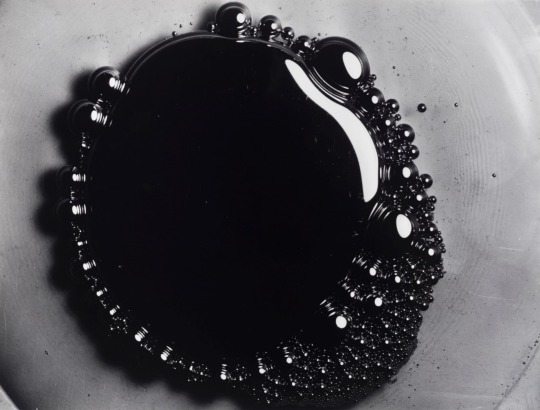

Fernando Nuño. Untitled [Mercury Series, Mines of Almadén y Arrayanes, S.A.], 1971.
62 notes
·
View notes
Text
En Guerrero se impulsa una infraestructura responsable | Evelyn Salgado

CHILPANCINGO * 17 de noviembre de 2022.
) Gobierno de Guerrero

Este gobierno está comprometido con el impulso al desarrollo responsable de infraestructura, con una visión de largo plazo y apegada a un correcto ordenamiento territorial, para promover un estado en mejores condiciones, señaló la gobernadora Evelyn Salgado Pineda, durante la inauguración del Sexto Seminario Internacional de Puentes que organiza la Asociación Mexicana de Ingeniería de Vías Terrestres, Asociación Civil (AMIVTAC).
Con la presencia del titular de la Secretaría de Infraestructura, Comunicaciones y Transportes (SCIT), Jorge Nuño Lara, la gobernadora agradeció el apoyo de la federación, para impulsar proyectos de relevancia como son la construcción de puentes, carreteras y actualmente la puesta en marcha del proyecto de los Caminos Artesanales en la Montaña.
"La construcción genera empleos, ventas en las diferentes industrias, nuevas cadenas de producción, desarrollo y bienestar, esto es lo que genera, por eso en Guerrero somos aliados de estos esfuerzos y por supuesto, abrazamos todos y cada uno de los proyectos que abonen y que detonen el crecimiento de nuestro estado y de nuestro país", expresó la

mandataria.
De igual manera enfatizó la coordinación de esfuerzos entre estados, municipios, las empresas, las cámaras y las asociaciones, para promover de manera prioritaria el desarrollo. Por ello reafirmó el compromiso de su gobierno con este sector, como aliados y amigos, para continuar trabajando de la mano para seguir transformando Guerrero.
En tanto que el titular de la SICT, agradeció a la gobernadora por su hospitalidad y por todo el trabajo coordinado que se ha logrado, en beneficio de las y los guerrerenses. Hizo un recuento de los grandes proyectos de infraestructura que se han desarrollado en estas tierras y que se han convertido en representantes de la ingeniería mexicana como los

puentes Mezcala, Papagayo y Barra Vieja, así como los 66 caminos artesanales que se encuentran en construcción.
Señaló que hay un compromiso de mantener todas las estructuras de los puentes, en óptimas condiciones, garantizando que las familias se trasladen de forma segura. Dijo que en México es prioritario incentivar la capacitación de nuevos ingenieros especialistas en puentes, los cuales deberán atender las demandas futuras y con ello fomentar el desarrollo económico del país.
Confió en que la realización de este seminario, en el que se realizarán conferencias, mesas redondas, así como talleres, permitirán poner en práctica la diversidad de conocimientos y técnicas, producto de un enriquecimiento de foros con expertos.

A nombre de los organizadores, el presidente de la 24 Mesa Directiva de la AMIVTAC, Jesús Sánchez Argüelles dio la bienvenida a los asistentes y agradeció a la gobernadora por todo su apoyo en la realización de este evento. Señaló la importancia de tener este tipo de encuentros, que sumados a las nuevas tecnologías, aportan un sin número de beneficios en el tema de la planeación e implementación de proyectos relacionados con la construcción de puentes.
En este encuentro, que se realiza del 16 al 18 de noviembre, se abordarán mesas redondas, conferencias y talleres con temas como: Problemas en la Construcción, Operación y Mantenimiento de Puentes en México, Ingeniería Estructural Forense en Puentes, Construcción de Puentes en la Ciudad de México, Dispositivos de Amortiguamiento Suplementario y Aislamiento, entre otros.
Asistieron el director general de Carreteras de la SICT, Jesús Felipe Verdugo López; el director general del Centro SICT Guerrero, Ricardo Alarcón Abarca; el director general del Sexto Seminario Internacional de Puentes, Fernando Isunza Mohedano; el delegado de la AMIVTAC en Guerrero, Joaquín Hernández Rodríguez, entre otros.



Read the full article
#EvelynSalgado#TransformandoGuerrero#AsociaciónCivil(AMIVTAC)#AsociaciónMexicanadeIngenieríadeVíasTerrestres#EvelynSalgadoPineda#GobiernodeGuerrero#SextoSeminarioInternacionaldePuentes
0 notes
Photo
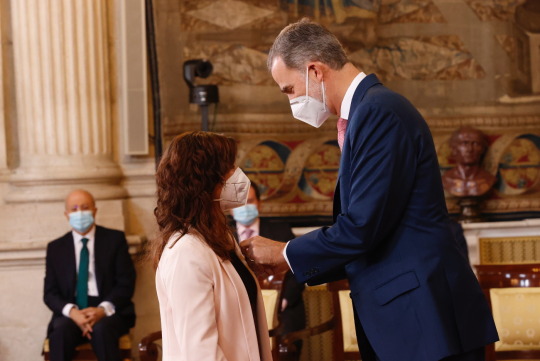
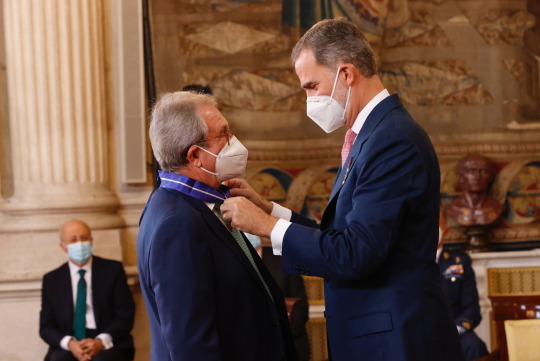
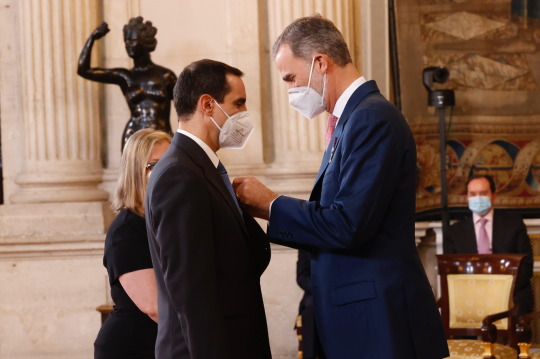



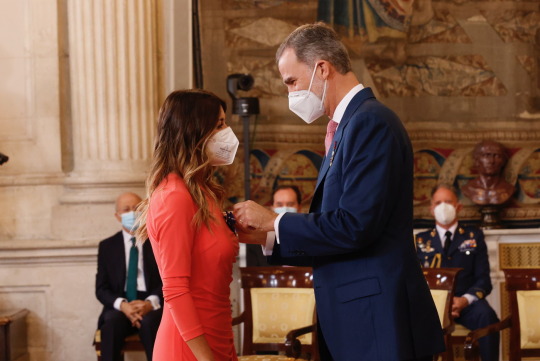
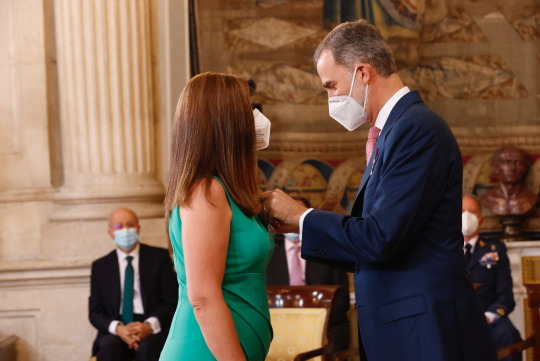


June 18, 2021: King Felipe, Queen Letizia, Princess Leonor and Infanta Sofia attended an event of delivery of the Order of Civil Merit Condecorations to mark the 7th anniversary of King Felipe’s proclamation.
On the occasion of the seventh anniversary of the Proclamation of His Majesty the King, as on previous occasions -2015 and 2019- it is a matter of expressing the recognition of the Crown to those who carry out their life and ordinary professional work in an exemplary way, at the service of society.
On this occasion, in a very special way, for their contribution during the challenge of Covid-19, we recognize citizens for their example of personal commitment and social contribution.
The selection, with criteria of representation and territorial and sectoral balance, is the result of the Crown’s contact with society and has been carried out with the institutional contribution of all the administrations and also of many other entities, organizations, associations and representative groups in different fields, labor, economic, social, educational and cultural. Those who have been recognized with the Medal of the Order of Civil Merit are a reflection of the situation experienced by millions of people in the time marked by the pandemic and its consequences.
The 17 Autonomous Communities and the two Autonomous Cities are represented, with twice the representation, the Communities with a population of more than 5 million (Andalusia, Catalonia, Valencian Community and Madrid). There are 16 women and 8 men aged between 30 and 74 years old.
The professions represented have to do with different sectors: Health, Research, Agriculture, Livestock, Fishing, Hospitality, Commerce, Transport, Logistics, Services, Volunteering, Education and Culture. During the most acute phase of the pandemic and confinement, all these sectors showed the fundamental role they play every day in the lives of citizens. There are five fundamental groups of awarded: those linked to the rural world and the primary sector, those related to knowledge management (education, culture and science), those linked to volunteering and the third sector, health workers and, finally, some of the professions that were shown, in addition to health workers, as essential during the confinement of the pandemic.
During the event, Their Majesties the King and Queen, HRH the Princess of Asturias and HRH the Infanta Doña Sofía were accompanied by the Minister of Foreign Affairs, European Union and Cooperation and Grand Chancellor of the Order of Civil Merit, Arancha González Spade; the Undersecretary of Foreign Affairs, European Union and Cooperation and Chancellor of the Order of Civil Merit, María Celsa Nuño; and by the general director of Protocol, Chancellery and Orders and secretary of the Order of Civil Merit, Caridad Batalla.
Elena Ochoa, who acted as master of ceremony, read the biographies of the citizens who received the decorations of the Order of Civil Merit, which were:
- Don David Lafuente Rico (1982), farmer from La Rioja.
- Doña Noelia Aparicio Martínez (1972), rancher from La Milla del Río (Castilla y León).
- Don Manuel Vinatea Fernández (1961), Sailor from Santoña (Cantabria).
- Doña Cristina Crespo Miñana (1973), materials researcher from Zaragoza (Aragon).
- Doña María del Mar Delgado Serrano (1967), researcher from Córdoba (Andalusia).
- Don Esteban Orenes Piñero (1978), biosanitary researcher from Murcia.
- Doña Cristina García Sánchez (1978), early childhood education teacher from Ceuta.
- Doña Natividad Baldominos Baldominos (1967), solidarity singer from Guadalajara (Castilla-La Mancha).
- Doña Carmen Martínez Valladares (1951), volunteer on the phone. of the hope of Silleda, Pontevedra (Galicia).
- Doña Margalida Jordà Murnar (1947), director of the educational project Naüm de Sineu, Mallorca (Balearic Islands).
- Don Miguel Herrera (1987), solidarity cook from Algodonales, Cádiz (Andalusia).
- Doña Silvia Cano Moreno (1970), doctor from Melilla.
- Don Fernando Gómez Gil (1980), nurse from Pamplona (Navarra).
- Doña Alice Mihaela Cozma (1988), ambulance driver from Extremadura.
- Doña Nuria Cascales Picó (1990), Pharmaceutical from Torremanzanas, Alicante (Valencian Community).
- Don Antonio Roldán Bonilla (1947), Mercamadrid worker in the Community of Madrid.
- Doña Cristina Díaz López (1976) and Don Sergio Mediavilla Cuesta (1974), owners of a grocery store and n the Community of Madrid.
- Mrs. Virginia Marquinez Insagurbe (1984), director of the Vitoria-Gasteiz post office (Basque Country).
- Don Albert Esteve Robles (1986), transporter from Lleida (Catalonia).
- Doña Yukonda Esparragoza Jiménez (1971), manager of a laundry in Gran Canaria (Canary Islands).
- Don Luis Alberto Ramos Fernández (1960), waste treatment worker in Oviedo (Principality of Asturias).
- Doña Marta Muñoz Escrivá (1991), hospitality assistant in Valencia (Valencian Community).
- Doña Elena García Solís (1979), supermarket cashier in Badalona (Catalonia).
At the end of the act in the Hall of Columns, the King and Queen, the Princess of Asturias and the Infanta Doña Sofía, went to the Hall of Halberdiers, where a group photograph with the decorated ones took place. Later, they held a meeting with the winning children of the school contest “What is a King for you?”
The Order of Civil Merit was instituted by King Alfonso XIII, by Royal Decree of June 25, 1926, to reward “the civic virtues of officials at the service of the State, as well as the extraordinary services of Spanish and foreign citizens in the good of the Nation ”.
The preamble to the order states that “its purpose is to reward merits of a civil nature, acquired by personnel dependent on any of the public Administrations” or “by persons outside the Administration, who render or have rendered relevant services to the State. , with extraordinary work, profitable initiatives, or with exemplary constancy in the fulfillment of their duties. This decoration may also be awarded to persons of foreign nationality, provided they have rendered distinguished services to Spain or a notable collaboration in all matters that benefit the Nation. His Majesty the King is the Grand Master of the Order of Civil Merit. All the decorations of this order will be conferred in his name and the corresponding titles will be authorized with the stamp of his signature.
#King Felipe#Queen Letizia#Princess Leonor#Infanta Sofia#King Felipe of Spain#Queen Letizia of Spain#Princess Leonor of Asturias#Infanta Sofia of Spain#King Felipe VI#Princess of Asturias#King Felipe VI of Spain#Official Event#20210618#June 2021
38 notes
·
View notes
Photo








Requested by anonymous: Isabel Barreto (1567-1622)
Considered as the first female Admiral in history, Isabel Barreto’s life is still not very well-known, as there are still several facts from her life up to discussion.
Her father has been disputed to be either Nuño Rodríguez de Barreto, conquistador of Peru, or Francisco Barreto, governor of the Portugese Indies. Either way, most sources agree on Isabel being descendant of Portuguese and Galician nobility. Her mother was definetly Mariana de Treviño, and had 11 children; Isabel herself was born in the year 1567, in either Pontevedra, Spain, or Lima, Peru.
She was married in 1585 to Álvaro de Mendaña (b.1542), a prominent sailor and Spanish adelantado. Isabel’s dowry allowed her husband to buy a new ship -the Santa Isabel- as well as supplies for his latest expedition to the Solomon Islands, which he had previously discovered in 1568. Isabel accompanied her husband to the expedition in 1595, along with three of her brothers, Lorenzo, Luis and Diego Barreto.
During the expedition, Isabel’s husband died from a fever in the island of Santa Cruz, possibly Malaria, after which Isabel decided to take command of the expedition herself, facing harsh weather conditions, shortage of supplies and a fierce rivalry with her crew, particularly her pilot Pedro Fernández de Quirós. She was described as an iron-willed woman with “a man’s spirit”, who was accused of being extremely cruel with her crewmen and the natives of the islands she governed. Aside from leading the expedition after her late husband, she became an adelantada herself -the first ever- as well as governor of the Solomon Islands and possibly the Island of Santa Cruz as well.
Isabel’s famous expedition ended the next year when she arrived to Manila, Philippines, where she met her second husband- Fernando de Castro, a Knight from the Order of Santiago. The newlyweds set sail for the Americas abord the San Jerónimo, arriving to the port of Acapulco, in present-day Mexico, in 1597. It is rumoured she became encomendadora of Guanato, while her husband was proposed for Governor of Philippines, yet none of that is completely certain. At some point they moved back to Peru, where it is possible she died there on the year 1622, while several historians debate whether or not she died in Galicia instead.
Sources:
http://dbe.rah.es/biografias/15487/isabel-barreto
https://mujeresquehacenlahistoria.blogspot.com/2011/10/siglo-xvi-isabel-barreto.html
https://www.mujeresenlahistoria.com/2013/01/la-primera-mujer-almirante-isabel.html
https://www.bbc.com/mundo/noticias-49978447
#gif#post#request#anon#isabel barreto#admiral#iberian history#american history#colonial period#virreinato del perú#solomon island#age of discovery#naval history#16th century#17th century#by sofy
54 notes
·
View notes
Text
Mécia Lopes de Haro, Queen of Portugal (wife of King Sancho II of Portugal)

Reign: 1240 – 1246
Mécia Lopes de Haro or Mencía López de Haro (c.1215–1270) was a Castilian noblewoman, the wife successively of count Álvaro Pérez de Castro and of King Sancho II of Portugal. The subsequent annulment of her marriage by Pope Innocent IV has led to disagreement over whether she should be counted among the queens consort of Portugal. She played a central role in the Portuguese political crisis of 1245.
Mécia Lopes was born in Biscay, the daughter of Lopes Díaz II de Haro, lord of Biscay, and of Urraca Alfonso of León. Her mother was an illegitimate daughter of Alfonso IX of León. She was thus niece of the reigning king, Ferdinand III of Castile.
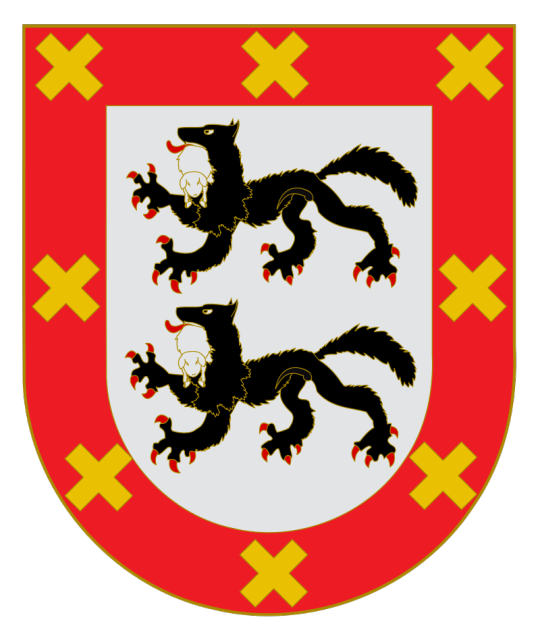
Mécia was married on 29 September 1234 to Álvaro Pérez de Castro, a magnate involved in the expansion of the Castilian kingdom into the region of Cordoba, whose first marriage to Aurembiaix, Countess of Urgell had been annulled in 1228, while Mécia's sister Teresa married Nuño, Count of Rousillon, a kinsman of the powerful House of Lara.
These consanguineous marriages were the cause of a dispute between Ferdinand III and Mecia's father Lopes Diaz II Haro and husband, the monarch confiscating some of the groom's lands. It was peacefully resolved through the mediation of Queens Berengaria of Castile and Elisabeth of Hohenstaufen, Ferdinand's mother and wife, respectively.
While the marriage proved childless, it did place Mécia in the midst of the struggles on the Cordoban frontier. After taking Cordoba, the king returned to Toledo, leaving Álvaro in charge of the stronghold of Martos. The abandonment of agriculture due to the conflict led to a localized famine, and Álvaro was forced to journey to the royal court to plead for assistance. The king granted him the equivalent of viceregal powers, as well as monetary support. However, in his absence his nephew, Tello, and the troops left behind decided to launch a military incursion into the territory of the enemy, Mécia was left virtually unprotected in Martos. The Moorish ruler of Arjona took advantage of this opportunity to invade the recently captured lands. In response, Mécia sent word to the missing troops, and according to Spanish historian Lafuente she then dress in soldiers' arms and paraded around the battlements. Having anticipated facing women and not armed men, the Moors slowed their approach and took defensive measures, allowing the missing Christian troops under Tello to return. They then launched a directed attack under the command of Diego Perez de Vargas which broke through the center of the enemy lines, dispersing them. On hearing of the danger under which his wife had been placed, Álvaro made to return, but became ill and died of an unnamed disease at Orgaz in 1239, or as some have it, 1240.
Mécia married again to King Sancho II of Portugal, son of Afonso II of Portugal and his wife, Queen Urraca of Castile. The legitimacy of this union has been contested, first by Portuguese historian António Brandão, who has been followed by several subsequent scholars in considering her a mistress, but that they married is documented by a papal bull Sua nobis of Pope Innocent IV, and is accepted by most historians.The date and place of the marriage is uncertain. It does not appear in the work of Rodrigo of Toledo, completed in March 1243 but also omitting Portuguese royal marriages from the year before, while the papal bull mentions it in 1245, suggesting it should be placed between these dates.

From the start, there were several reasons for the marriage to be portrayed in a bad light. She brought with her from her foreign land the specter of domination by the powerful neighboring Kingdom of Castile. Further, since she was a widow and the king was her mother's first cousin, she deviated from the ideal of a virgin bride and tainted the marriage with consanguinity. She was not a royal princess and had no direct connections in either Portugal or Castile, whose king abandoned her after the death of her husband. She exacerbated her political isolation by surrounding herself with Castilian-raised servants and maids, making it difficult for Portuguese courtiers to use Mécia as an avenue for approaching the king. She was thus quickly rejected by nobility and populace. The degree of the discontent can be seen in the oft-repeated claim that the king was "bewitched by the arts of D. Mécia de Haro."
The problems in Portugal predated the arrival of Mécia. With the years of Christian conquests in the wars with the Moors, the king had taken some liberties as the country enjoyed peace and the king basked in the glow and pride of military success. However, the king then decided to replace the counselors of the royal court with his military companions, effectively instituting a military dictatorship. This change proved fatal, as it embroiled the council in conflicts that tarnished the image of the king, and led to what some historians have called an anarchy. Mécia thus entered the Portuguese stage at the start of a period of political instability, a civil war that eventually resulted in the deposition of her husband, and the coincidence led to her being blamed for his downfall. Later chroniclers have gone so far as to suggest that Sancho was a good king until his marriage, and his subsequent difficulties were due to her bad influences. However, such writings are biased by the need among his successors to justify his deposition.
The Portuguese clergy rose against the marriage, not so much because of direct opposition but as an indirect way of embarrassing the king in order to hasten his fall. Their contempt for the king arose from various perceived injustices, such as the revocation of a grant to the monastery of Bouco made by Afonso I of Portugal and confirmed by Afonso II.
Pope Innocent IV addressed a papal bull to Afonso, Count of Boulogne, brother to the king and aspirant to the throne, in which he requested that Afonso raise troops from Boulogne to assist the church in the Holy Land. Given the plans of the Portuguese clergy and the pope, this seems simply to have been a pretext to allow Afonso to bring armed men to Lisbon. While Afonso was heir to Sancho, this could change at any time were the childless Mécia to produce an heir and so he set about separating the spouses. He focused on their consanguinity, both descending from Afonso I of Portugal, a relationship within a degree prohibited by the church but tolerated in the Iberian social context. Afonso took this to the pope, who issued a bull that decried the state of the kingdom, and backed by complaints from the Portuguese bishops, threatened that unless Sancho live up to his responsibilities, "appropriate measures" would be taken. Sancho refused to repudiate his wife, and the pope then carried through with his threat, annulling the marriage.
On 24 July and 1 August 1245, two bulls were promulgated, the first addressed to the barons of the kingdom, the second to the clergy, which decreed the deposition of the king. The king sought help from his brother Afonso, the very man whose maneuvering had led to the deposition. There then occurred an event that directly involved Mécia. A nobleman named Raimundo Viegas de Portocarreiro, accompanied by the men of the Count of Boulogne, entered the royal palace at Coimbra and snatched her from the royal bedchamber, taking her to the palace at Vila Nova de Ourém. Sancho, embarrassed at the kidnapping and finding himself powerless to recover his wife, abdicated and fled to Toledo, dying in 1248. His will did not name his wife, suggesting that he may have thought her complicit in the kidnapping, a claim also hinted at by later chroniclers although no evidence is found in contemporary sources.
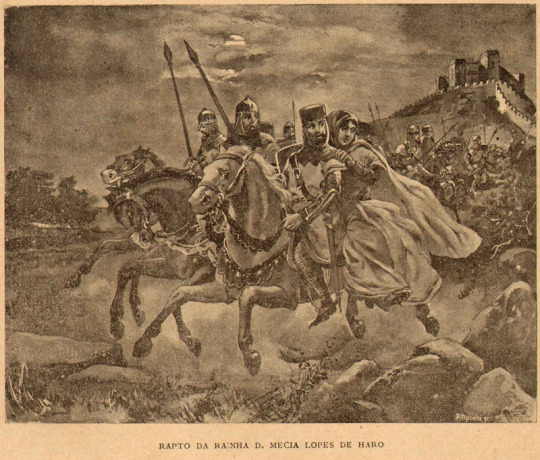
Following her kidnapping, Mécia took up residence in Ourém. There is documentation of Mécia making several donations there, and she was protected by troops of the court, with which she retained good relations. The alcaide of the town, Inigo de Ortiz, has a Biscayan name, suggesting that she had appointed him. According to tradition, she held lands at Torres Novas, Santa Eulália and Ourém, and a marginal note in a contemporary document indicates that they were held by Mécia.

Then her fate becomes less certain. Rui de Pina, the chronicler of Sancho II, says that she left Ourém for Galicia, which seems unlikely. There is a surviving document, dating 24 February 1257, which while not specifying the location, reports Mécia and her relative Rodrigo Gonzalez acting as executors to Teresa Aires, making certain gifts to the convent of Benavides, suggesting that at the time she resided in the area of Castile. An infante Fernando, who lived there, became sole heir of Mécia, and also disputed Sancho's inheritance. According to tradition, Mécia died in 1270 at Palencia, where she held lands, and she was buried at Nájera in the Benedictine convent of Santa Maria, in the Chapel of the Cross. Her tomb, supported by four lions and bearing the arms of Portugal, features a woman in the dress of Biscay.
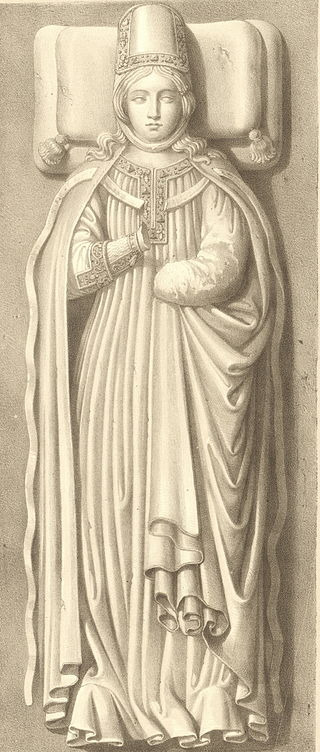
34 notes
·
View notes
Text
TONALLAN TLATOHCAYOTL. “Aquí se dice, aquí se habla.. como llegaron, como entraron los ancianos. Los nombrados teochichimecas, la gente de Aztlan. Los mexicanos.. que vinieron a buscar tierras, a merecerlas, aquí en la gran Ciudad de México-Tenochtitlán. Lugar de su fama, de su dechado”.
-Fernando Alvarado Tezozomoc. Hijo de Francisca de Moctezuma (hija de Moctezuma Xocoyotzin) y Diego Huanitzin (nieto de Axayacatl)🗣
06:56 am. Tonallan, Xalisco.
- Oquixaco in Tonatiuh. In Totonametl; Xiuhpiltontli, in Cuauhtlenanitl auh. ¿Cuen onotlatocaz, cuen cenilhuitiz? ¿Cuiz itla ipan mochiva in icuitlapil in iatlapal?
(Ha salido el Sol. El que hace la Luz, el que hace el Calor. Niño precioso, Águila que asciende. ¿Como seguirás tu camino? ¿Como harás el día, acaso algo sucederá con nosotros, su cola, sus alas?
- Conilhuiaya: Ma ximotequitilli, ma ximotlacotilli. Totecuicoe. Auh inin momoztlae in icuac valquixaya Tonatiuh mitoaya.
(Le decían: Dígnate a hacer tu oficio y cumplir con tu trabajo. Señor Nuestro. Y esto se decía cada día cuando salía el Sol).
En el año 12-Conejo (Matlactiomome-Tochtli). En la veintena de Atlacahualo (cuando se van las aguas). En el día de 4-perro (Nahui Itzcuintli); habrían de decirse por última vez las “palabras sagradas que se dirigían al Sol. Momento sagrado cuando el teopizqui o sacerdote habría de realizar la invocación del “rayo que crea la luz y el calor.. llamado Totonametl”.
Llamado también, “Águila que asciende” o “Huitzilopochtli”; encarnaba en el personaje tal Epifanía que “parecía como si estuviera contemplando las plumas del Águila Sagrada en su tocado”.
Aunado a este momento sublime, seguían los sacrificios de codornices llamado “Xollin Itlacotonalix”:
- In momoxtlae. Inic valquixa Tonatiuh. Tlacotonacoya iuan tlenamacoya. Auh inic tlacotonaloya: quiquech cotonaya in xollin, coniyaviliaya in Tonatiuh.
(Cada día. Al salir el Sol. Era hecho el sacrificio de codornices y ofrecimiento de copal. Y así, se sacrificaban a las codornices: les cortaban el cuello, las levantaban en ofrenda al Sol).
Cómo servían al Sol a diversas horas del día y la noche. Códice Matritense✍🏽
Si bien, esta ceremonia era de carácter diaria no deja de resaltar el sesgo y la connotación de celebrarla en particular el 21 de marzo. Fecha especial de carácter astronómico puesto que el día y la noche se equilibran en duración. Sin embargo y con notable particularidad, el llamado “Tonaya” o Amanecer tomaba un espacio por demás especial, cuando la hoguera celestial encendía el pebetero o cuna solar.
Si miramos el relieve y la planicie al oriente del actual poblado de Tonalá, nos daremos cuenta que se encuentra en línea recta con una pequeña cañada o valle situada al sur, al pie del cerro de la “Santa Fe”, llamado Tololoteotl o “Dios Gordo” por los naturales de esta tierra.
Hacia el lado opuesto, comienza con pequeños montes que habrán de marcar las estaciones y salidas del Sol enclavadas hacia el poblado del actual Acatic.
Pues bien, entre estos cerros y valles se efectúa el nacimiento de un Sol portentoso y magnánimo como en ningún otro día del año. Literalmente, este día ahí nace el Sol. Por ello es que quizá el nahuatlato o traductor que enviaría Nuño de Guzmán a espiar a este territorio, llegaría con el magnífico nombre de Tonallan, Tonallan... que representa tanto como el lugar donde se abraza al Sol, o donde hace calor, seguido de donde se cuentan los días, y finalmente y por “vox populi”, donde nace el Sol!!
Sabemos que los “Tebles chichimecas” (como los llamaba Nuño de Guzmán) o Teochichimecas, fueron los antecesores de los aguerridos y ceremoniosos indígenas Tecos de la región.
Herederos de un gran linaje de los pueblos nahuas venidos del norte. Al menos eso le narró el anciano Petlacatl de Ahuacatlan al cronista español durante la conquista del territorio Xalisco, Nayarit.
Los Tecos de Tonalá eran afectos mayormente a Huitzilopochtli, su patrono de la guerra con su teocalli en la cima del xictepetl. A Heri, protector del trabajo y la inteligencia de los macehuales. De Tenaguchi, una de las tantas advocaciones de Tezcatlipoca, el dueño de la suerte y la adivinacion. Finalmente de Teopilzintli; el niño inquieto del buen y mal tiempo.
Su calendario, dividido en dos representaciones; por un lado constaba de 260 días de festividad y por otro, 360 días de cotidianidad más 5 de infortunios. Así era la vida que transcurría en ciclos de 13, 26, 52 y hasta 104 años.
Pero, ¿como retratar el instante perfecto para iniciar estos ciclos? La respuesta yace quizá como lo respondieron la mayoría de culturas americanas durante siglos de su historia hasta antes de la conquista. Marcando piedras a través de posiciones perfectamente alineadas con eventos astronómicos. Tecnología rudimentaria si se compara con la actual pero efectiva en un 100 %.
A estas alturas se hace obligado hablar de una invaluable como única en la región, llamada “la piedra del sol” que funcionaba como un modesto marcador solar.
Por definición geográfica, es una roca basáltica de considerable proporción colocada estratégicamente bajo la llamada “Loma de Galán” situada al oriente de Tonalá.
Su cara principal, guarda dos inscripciones notables: un perfecto halo solar concéntrico y en su interior la cara “del niño precioso”, representando a su vástago en forma de “Totonametl”.
Lo más notable de todo este asunto; es que siempre estuvo perfectamente “orientada” al amanecer del Sol durante la llegada de la primavera; esto es, pudiendo ocurrir el 20 o 21 de marzo de nuestro actual calendario romano-gregoriano totalmente europeo aunque coincidente en algunos aspectos con el ancestral nahua.
Monolito que increíblemente fue ignorado por los rimbombantes cronistas coloniales y viajeros de la época. Hasta el propio Anesagasti la paso por alto. Para nuestra fortuna ahí estuvo siempre, esperando cumplir su función de retratar literalmente la salida del Sol cada año, por lo menos documentado hasta el año del 2014. Puesto que a finales de ese año se decidió trasladarla a la cima del xictepetl donde perdió todo contexto histórico, geográfico y astronómico.
Lo que nunca han entendido los avezados, es que no se interpreta como un monolito suntuario, sino más bien pertenece al orden utilitario, haciendo un simil “como quien mira el reloj de un campanario para conocer la hora exacta del día”.
Finalmente, hoy es el día 4-Perro (Nahui-Ixcuintli), del mes Atlacahualo o descenso de las aguas, perteneciente al año 9-Casa (Chiconahui-Calli). Desde el amanecer, el gran Tonatiuh cumplió su promesa hecha a los macehuales “de regresar de las aguas del occidente para renacer nuevamente”.
Las ausentes fueron las míticas piedras del Sol y la Campana por culpa de incapacidad para observar con detenimiento el tiempo.
Cariacha (hasta pronto)..
#soydetonala🌞
#tierradenahuales👹

1 note
·
View note
Video
vimeo
Audacity Partners history / EL PAÍS ECONOMÍA
Audacity Partners is at the forefront of content and experience pioneering and innovation since 2006. From the invention of the Newsbook four years ahead of the iPad, to the first digital editions of 'THE TIMES' and the 'Wall Street Journal' in 2009 on a Cambridge Plastic Logic tablet; to the creation of 'The Daily' ( prototype 1 ) ( prototype 2 ) ( prototype 3 ) ( prototype 4 ) with Steve Jobs and Rupert Murdoch, or to the latest Snap’s content Discover platform and narrative.
Audacity Partners collaborates with brands, retailers and publishers to design and develop new products, and to define long-term editorial and commercial growth strategies.
This video summarises our recent history. It also dives deeper into our latest project ( EL PAÍS ECONOMÍA ) and signals our next step, LYXSTREET —a digital ‘Bond Street’ that increases ROI on content spend, accelerates commerce, and favours a new revenue stream for luxury brands.
- - - -
Transcription
I’m the founder of Audacity Partners, a London-based strategic innovation studio helping CEOs and market leaders to drive digital transformation through radical products that the world’s never seen.
Former Director of Innovation at News Corp, I envisioned the iPad in 2006, Pinterest in 2008, Siri in 2009. In 2010, I created the first tablet editions for The Times and The Daily ( an iPad only venture with Rupert Murdoch and Steve Jobs ). In 2012 I defined the embryo of what today is the content experience behind Snap’s Discover.
From the development of responsive websites to the creation of native apps, we collaborate with brands, retailers and publishers to design new products, and to define long-term growth strategies.
In 2015, we started working with PRISA —the world’s leading Spanish and Portuguese-language quality media group, reaching out to more than 700 million people.
Our first project was the redefinition of EL PAÍS SEMANAL, which was successfully evolved into a luxury product. Both in print and in digital.
We announce today that we are the creators behind EL PAÍS ECONOMÍA, from business strategy to the creation of the new products and their new brand identity.
EL PAÍS ECONOMÍA is the largest Business portal in Spanish. It aims to make Economy relevant, useful and accesible to everyone.
We have methodically researched the existing offering. Established a benchmark of more than 1,300 media on both sides of the Atlantic. And identified trends as well as new opportunities. To better understand customers needs and behaviours, we used a revolutionary distribution analytics tool, named Croma. This allowed us to identify three main audiences:
— Companies, executives and investors.
— Consumers, savers and self-employees.
— And new professionals in the new economy : Emerging leaders with special attention to women. And entrepreneurs / innovators.
EL PAIS ECONOMÍA aims to serve these three audiences. Two new products are the key of the new offering.
On one hand, CincoDías, veteran of the financial press, matures as an specialised vertical focused on Markets, Companies and Money.
On another hand, we envisioned a new product named ‘retina’ that targets professionals of the new economy. It is focused on digital transformation, innovation, productivity and strategy.
‘retina’ exists to help emerging leaders and entrepreneurs to work intelligently, create value, innovate and grow, and balance life and work.
Over the past 7 months, we have collaborated with some of the most talented editors, journalists and developers. This is an energetic and cross disciplinary team that made all this possible. The print and digital products launched today signal the beginning of a wonderful journey —not a final destination. More features are being developed and will be implemented continuously.
As for Audacity Partners, our next stop is LYXSTREET. A product of our own, introducing the next generation of e-commerce for luxury brands, which will be launched in London in Q4 this year.
- - - - - - - - -
Alfredo Triviño, Managing Partner, Strategy, Editorial and Creative Director.
Rickard Frank, Creative Director.
Juan Melano, Senior Partner and CEO of Croma.
Miguel Suárez, Senior Partner.
Arantxa Martínez, Director.
Santi G. Barros, video producer-director.
- - - - -
Other projects
LYXSTREET
IBM
SNAP
Olympics
SHARED PLANET
SANTANDER
- - - - - -
EL PAÍS team
Many thanks for the opportunity and great effort from the team at EL PAÍS. It's been an absolute pleasure to work with :
Manuel Mirat, CEO
Antonio Caño, Editor in Chief
Ignacio Soto, PRISA Group CBO
José Luis Gómez Mosquera, MD
Miguel Galera, COO of Mitula Group
Jorge Rivera, Deputy Editor in Chief
Noemí Ramírez, CDO
Vanesa Hernández, Operations Director
Ricardo de Querol, Editor in Chief of CincoDías
Jaime García Cantero, Retina Director
Nuño Rodrigo, Head of Content
Pablo Delgado, Digital Development Director
Fernando Hernández, Art Director
Jacinto Corral ( and Rubén ), Head of Development
Virginia Béjar, MD Events
Remigio Lluch, CMO
Pedro Zuazua, Communication Director
Patricia Tortajada, Head of Marketing
Paula Villamayor, Head of Events
Pablo Caño, CBO
Belen Villa
2 notes
·
View notes
Photo

HISTORIA UNIVERSAL - ALFONSO X - EL SABIO -
Alfonso X, el Sabio (1221-1284), nació en Toledo en noviembre de 1221. Ascendió al trono de Castilla y León tras la muerte de su padre Fernando III, el Santo, a la edad de 31 años. Falleció el cuatro de abril de 1284, en Sevilla. Está enterrado en la iglesia de Santa María de Sevilla. Participó en varias expediciones contra los musulmanes y en la conquista de Murcia, en 1249, que le fue encomendada a su padre. No desconocía la política interior y la diplomacia, al haber actuado de mediador entre su padre y el rebelde Diego López III de Haro, señor de Vizcaya; del mismo modo, participó en el tratado de Almizra[1], en el año 1244, firmado con el Rey aragonés Jaime I, el Conquistador, su futuro suegro. Como garantía de esta paz, se acordó el matrimonio de Alfonso con Violante, hija del Monarca aragonés. El matrimonio se celebró en la Colegiata de Valladolid.
Nada más acceder al trono, Alfonso X convocó Cortes en Savilla. Donde se tomó la decisión de devaluar la moneda ante la escasez que sufría el erario público, lo que trajo los efectos indeseados de la especulación y la subida de precios, por lo que el Monarca vio a obligado a fijar las valías, lo que empeoró mucho más la situación. Finalmente tuvo que revocar esa medida, pues todas las gentes se vieron en gran afincamiento, y permitir la oscilación de los precios en el marcado.
El propósito de Alfonso X de llevar la guerra al Norte de África se vio truncado por la negativa del Monarca portugués, Alfonso III a entregarle el Algarve, que Sancho II de Portugal le había cedido en agradecimiento por la ayuda que le había prestado para recuperar su reino. Gracias a la intervención del Papa Inocencio IV no estallaron las hostilidades; Alfonso III aceptó que el Algarve quedara como feudo castellano. Con este motivo, se concertó el matrimonio del Monarca portugués con Beatriz, hija bastarda del Rey Castellano y de Mayor Guillén de Guzmán, a pesar de que el portugués ya estaba casado, lo que acarrearía disturbios políticos en el Reino luso. Más tarde, a ruegos de su hija Beatriz, Alfonso X cedería el Algarve a su yerno (1253).
La muerte de Teobaldo I de Navarra en 1253, abrió un nuevo conflicto. Alfonso X, preocupado por la influencia que los franceses ejercían en Navarra, se dispuso a intervenir para apoderarse del Reino. Margarita, viuda de Teobaldo I, temerosa de la amenaza castellana se acogió a la protección del Rey aragonés Jaime I, el Conquistador. Cuando Alfonso X amenazó la frontera navarra, se encontró con la decidida oposición del aragonés. Gracias a la intervención de los prelados se pudo evitar la guerra, y así, Teobaldo II, hijo de Teobaldo I y Margarita, pudo comenzar a reinar en Navarra.
Las diferencias entre Alfonso X y Jaime I se prolongaron hasta 1256. La desconfianza que el aragonés guardaba hacia Castilla se basaba en que ésta mantenía en Murcia más tropas de las necesarias. Por estas fechas, comenzaron los abandonos y las rebeldías de los nobles, que amargaron los últimos años de Alfonso X. Jaime I acogió gustoso a los rebeldes, entre los que se encontraba el poderoso Diego López de Haro, que se puso al servicio del Monarca aragonés. Lo más grave fue que Enrique, hermano de Alfonso X, después de sublevarse en Andalucía, se refugió en Aragón, en 1255. La reunión que ambos Monarcas mantuvieron en Soria (1256) puso fin a las desconfianzas y Jaime I retiró su apoyo a los nobles rebeldes.
A partir de 1256, el interés de Alfonso X se centró en lo que entonces se llamó “el fecho del imperio”. Con la muerte de Fernando III[2] en 1250, la Corona del Imperio quedó vacante y Alfonso X, ahora Jefe de la casa de Suabia[3], tenía un derecho teórico a la Corona, ya que su madre, Beatriz, era hija de Felipe de Suabia, Príncipe electo del Imperio. La República de Pisa presentó la candidatura de Alfonso X, quien, obsesionado por el sueño imperial, aceptó, asegurando a los pisanos sustanciosas ventajas comerciales. Sin embargo, el Imperio era electivo y Alfonso X debía conseguir la voluntad de los electores alemanes, lo que suponía cuantiosos gastos. Los siete electores nominaron a Ricardo de Cornualles[4], hermano de Enrique II de Inglaterra, y a Alfonso X como posibles “Emperadores”. Desde 1257 hasta 1275, se sucedieron interminables y complicadas negociaciones, que originaron elevados gastos, para los que hubo que arbitrar subsidios extraordinarios. Todos los esfuerzos de Alfonso X para obtener la Corona Imperial fueron inútiles. En 1273, muerto Ricardo de Cornualles, fue elegido candidato Rodolfo de Habsburgo[5].
En 1274, el Papa Gregorio X reconoció a Rodolfo como Emperador e invitaba a Alfonso X a renunciar a su candidatura, porque el Papado siempre se mostró contrario a la elección del Monarca castellano. Alfonso X no se resignó y solicitó una entrevista con el Papa, que se le concedió debido a su insistencia. Dejando como Regente del Reino a su hijo Fernando, Alfonso X partió para Avignon sede del Papado en 1275, se entrevistó con el Papa en Beaucaire[6]. Tras unas largas conversaciones, que se prolongaron durante junio y julio, fueron rechazadas todas sus peticiones, por lo que Alfonso X regresó a Castilla totalmente derrotado y desmoralizado.
Mientras se desarrollaban estos acontecimientos, Alfonso X tuvo que hacer frente a otros problemas mucho más graves. Algunas de las plazas conquistadas por Fernando III durante la conquista de Sevilla a los moros, se volvieron a perder, así que Alfonso X tuvo que hacer un nuevo esfuerzo para recuperarlas. La ciudad ovetense de Niebla, que venía pagando tributo, se sublevó en 1261, confiando en sus poderosas murallas y en lo escaso de recursos en que andaba el Monarca castellano. Pero Alfonso X, aunque con mucho esfuerzo, pudo superar las dificultades y sitiar la ciudad. Mientras los castellanos batían las altas murallas de Niebla con sus viejas máquinas de guerra, los musulmanes respondían con su Artillería, que hasta entonces no se había empleado en la Península. A pesar de todo, Niebla se rindió en 1262.
Apenas calmado el fragor de Niebla, tuvo lugar la sublevación de los mudéjares de Murcia en 1263, que contaron con el apoyo de los granadinos, cuyo Rey, Muhammad I, fue el verdadero instigador del levantamiento. En muy poco tiempo, los sublevados tomaron numerosas poblaciones de Murcia y Andalucía. Alfonso X se vio obligado a movilizar todos sus efectivos para sofocar la rebelión andaluza. Incapaz de sofocar el levantamiento de Murcia, tuvo que solicitar la ayuda del aragonés Jaime I. Con grandes esfuerzos, pudo Alfonso X ir pacificando Andalucía, mientras el aragonés recobraba Murcia. En 1266, la guerra había terminado y el Monarca aragonés devolvía al castellano la pacificada Murcia. Con este acto quedaba ratificada la concordia entre ambos Soberanos. Muhammad I de Granada se comprometió a pagar 250.000 maravedís, con lo que seguía siendo tributaria de Castilla.
Los elevados gastos que exigía la candidatura de Alfonso X al Sacro Imperio Romano, las liberalidades del Rey y la suntuosidad de su Corte obligaron a bajar la ley de la moneda y a imponer nuevas tasas. Medidas que acrecentaron la impopularidad del Monarca. La nobleza, que ya venía manifestando su descontento, tomó estos motivos como pretexto para sublevarse, aunque sus razones eran otras. En el fondo, subyacía su disgusto por las pretensiones absolutistas de la Monarquía, cuando lo que ellos querían era compartir el poder con el Rey. El conflicto tuvo como protagonista al hermano del Monarca, Felipe, Arzobispo de Sevilla, al que se fueron sumando Nuño González de Lara, Lope Díaz de Haro, etc. Pidieron los nobles rebeldes la ayuda de Jaime I, el Conquistador, deseando mantener la paz con Alfonso X, más éste no aceptó. Si Alfonso X hubiera actuado con más energía habría acabado con la rebelión, pero al limitarse al envío de mensajeros provocó que los nobles se hicieran más exigentes en sus demandas. La necesidad que tenía el Monarca del apoyo de los nobles para su causa imperialista, máxime cuando había fallecido su opositor, Ricardo de Cornualles, le llevó a otorgar concesiones más allá de lo que la prudencia aconsejaba. En 1273 se llegó a los acuerdos de Almagro, en los que la nobleza consiguió lo que quería y en donde la intervención de su mujer, la reina Violante, hija del Rey Jaime I el Conquistador, fue decisiva.
En 1275, Alfonso X partió para Avignon, otra vez, a entrevistarse con el Papa y negociar su candidatura al Imperio. Su primogénito, Fernando de la Cerda, quedó como Regente del Reino. Los benimerines del Norte de África, de acuerdo con el Rey de Granada, desembarcaron en Algeciras. A fin de evitar el peligro, Fernando partió de Burgos hacía Andalucía, deteniéndose algunos días en Villa Real (Ciudad Real), para dar tiempo que el Ejército se agrupase. Desgraciadamente, cayó enfermo falleciendo a los pocos días. El segundo hijo de Alfonso X, Sancho, acudió a Villa Real, que con rapidez y energía asumió el mando del Ejército. En Sevilla ordenó el aparejamiento de una Armada para impedir la llegada de abastecimiento a los benimerines de Marruecos. Esta medida hizo temer al emir benimerín, Yakub ibn Yussuf, la posibilidad de quedarse incomunicado, por lo que antes de que la flota cristiana estuviese dispuesta, embarcaron rumbo a sus bases marroquíes a finales de 1275.
El éxito militar de Sancho complicó la sucesión al trono. Alfonso X hundido por su fracaso en Avignon, tuvo que enfrentarse a otro litigio, que su sempiterna vacilación complicó de una forma increíble. La descendencia que dejaba Fernando de la Cerda, de acuerdo con la Ley de las Siete Partidas[7] que establecía el nuevo sistema de primogenitura, tenía derecho al Trono. Esto lo sabía Alfonso X, pues fue él quien mandó recopilar estas leyes, aunque no entraron en vigor hasta el Reinado de Alfonso XI. Sancho, que sabía todo esto, no estaba dispuesto a dejarse arrebatar el Trono por su sobrino Alfonso de la Cerda. En 1276, convocó el Rey Cortes en Segovia haciendo reconocer y jurar como heredero del Trono de Castilla a Sancho. Violante, la Reina madre, que defendía el derecho de sus nietos a la Corona, temía que les pudiera ocurrir algún percance, huyó con ellos y con la viuda de su hijo Fernando, Blanca, a Aragón. Allí se puso al amparo de Pedro III, que por la muerte de su padre Jaime I, el Conquistador acababa de heredar la Corona. Sospechando Alfonso X que su hermano Fadrique fue el organizador de la huida, ayudado por Simón Ruiz, Señor de los Cameros[8], ordenó a su hijo Sancho que los mandara detener y los ejecutara por el delito de alta traición que habían cometido. Sin juicio previo, el Señor de los Cameros fue condenado a la hoguera y a Fadrique lo ahogaron.
Durante varios años la cuestión sucesoria emponzoñó la política castellana. Metido en un callejón sin salida, Alfonso X quiso pactar una solución intermedia y propuso la división de su Reino entre Sancho y los infantes de la Cerda. Pero Castilla y Sancho se negaron a la partición y aceptaron la guerra civil como mal menor. Por otra parte, Sancho mantuvo una entrevista con Pedro III de Aragón, en Requena, consiguiendo que la Reina madre regresara a Castilla y que firmara una concordia de paz con el aragonés.
Los errores y desaciertos de Alfonso X acabaron por enajenarle la voluntad del pueblo. Incapaz de convencer a su hijo Sancho para que aceptara sus proposiciones, decidió hacer testamento en favor de sus nietos, los infantes de la Cerda, y desheredar a Sancho. Recluido en Sevilla, abandono de todos y falto de recursos económicos, Alfonso X tuvo que recurrir a enviar su Corona al emir de Marruecos para solicitar un préstamo; que el Príncipe musulmán se lo concedió por valor de 60.000 doblas de oro.
Alfonso X falleció en Sevilla, en abril de 1284, siendo enterrado, de acuerdo con su voluntad, junto a su padre, Fernando III, el Santo. Muerto el Monarca, nadie quiso continuar la guerra civil, por lo que Sancho IV se convirtió en Rey de Castilla y León.
Alfonso X se había casado en 1246, siendo aún infante, con la hija del monarca aragonés, Jaime I el Conquistador, Violante de 12 años de edad, por lo que el matrimonio no se consumó hasta dos años más tarde. Alfonso X, preocupado por la falta de fecundidad de su esposa, decidió repudiarla y contraer matrimonio con Cristina, hija del Rey de Noruega. Más cuando ésta llegó a Burgos en 1254, Violante ya era madre de Berenguela. Alfonso X arregló tan delicada situación casando a Cristina con su hermano Enrique. Posteriormente vino al mundo Fernando, llamado de la Cerda porque nació con un largo mechón de pelo en el pecho, que sería el heredero de la Corona. Fernando se casó con Blanca, hija de San Luis de Francia, naciendo de éste matrimonio, Alfonso y Fernando, que, de acuerdo con el Código de las Siete Partidas, tendrían derecho a heredar el Trono a la muerte de su padre. El segundo varón de Alfonso X fue Sancho, que sería Rey de Castilla y León. Alfonso X tuvo más hijos: Pedro, Juan, Jaime, Beatriz, Violante, Isabel y Leonor.
Si en el contexto político, Alfonso X fue un Monarca irresoluto que hizo de él un desventurado hombre de Gobierno, en al campo cultural realizó una labor tan admirable que bien merece haber pasado a la posteridad como el Rey Sabio. Basta destacar en su producción literaria las maravillosas Cantigas e Loores de Santa María, y el impulso que dio a la Escuela de Traductores de Toledo. En cuanto a la labor legislativa, destaca el célebre Código de las Siete Partidas, que marcó el desarrollo posterior del derecho en Castilla.
Autor: José Alberto Cepas Palanca para revista de historia
7 notes
·
View notes
Photo

Fernando Nuño (1938-1996) - Untitled, n/d.
45 notes
·
View notes
Photo

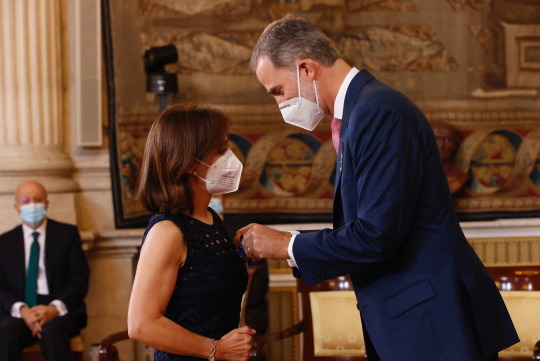

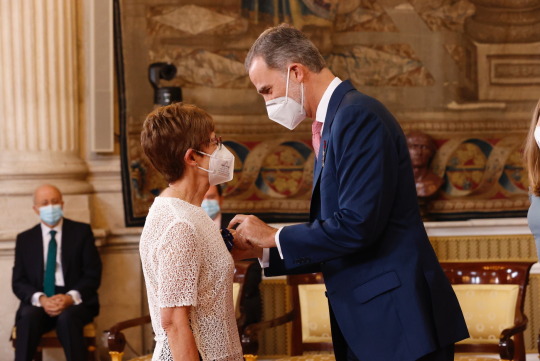
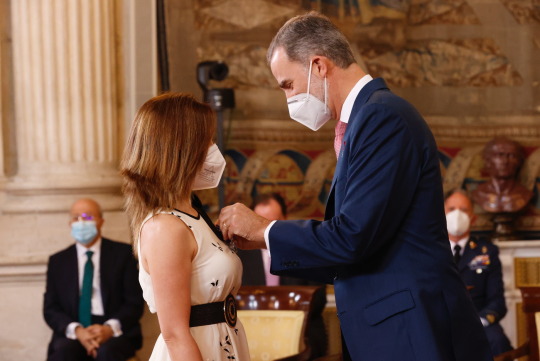
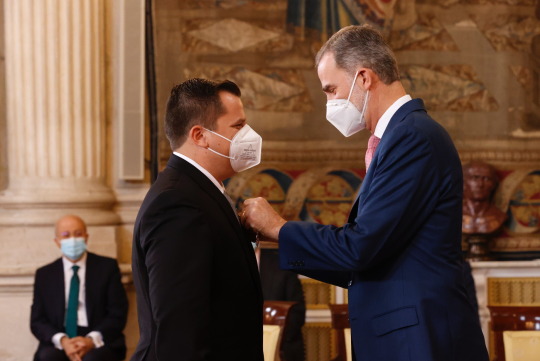



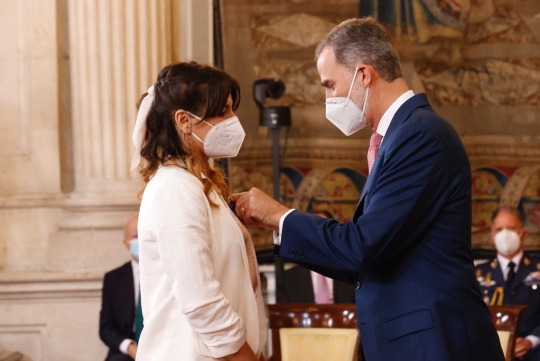
June 18, 2021: King Felipe, Queen Letizia, Princess Leonor and Infanta Sofia attended an event of delivery of the Order of Civil Merit Condecorations to mark the 7th anniversary of King Felipe’s proclamation.
On the occasion of the seventh anniversary of the Proclamation of His Majesty the King, as on previous occasions -2015 and 2019- it is a matter of expressing the recognition of the Crown to those who carry out their life and ordinary professional work in an exemplary way, at the service of society.
On this occasion, in a very special way, for their contribution during the challenge of Covid-19, we recognize citizens for their example of personal commitment and social contribution.
The selection, with criteria of representation and territorial and sectoral balance, is the result of the Crown’s contact with society and has been carried out with the institutional contribution of all the administrations and also of many other entities, organizations, associations and representative groups in different fields, labor, economic, social, educational and cultural. Those who have been recognized with the Medal of the Order of Civil Merit are a reflection of the situation experienced by millions of people in the time marked by the pandemic and its consequences.
The 17 Autonomous Communities and the two Autonomous Cities are represented, with twice the representation, the Communities with a population of more than 5 million (Andalusia, Catalonia, Valencian Community and Madrid). There are 16 women and 8 men aged between 30 and 74 years old.
The professions represented have to do with different sectors: Health, Research, Agriculture, Livestock, Fishing, Hospitality, Commerce, Transport, Logistics, Services, Volunteering, Education and Culture. During the most acute phase of the pandemic and confinement, all these sectors showed the fundamental role they play every day in the lives of citizens. There are five fundamental groups of awarded: those linked to the rural world and the primary sector, those related to knowledge management (education, culture and science), those linked to volunteering and the third sector, health workers and, finally, some of the professions that were shown, in addition to health workers, as essential during the confinement of the pandemic.
During the event, Their Majesties the King and Queen, HRH the Princess of Asturias and HRH the Infanta Doña Sofía were accompanied by the Minister of Foreign Affairs, European Union and Cooperation and Grand Chancellor of the Order of Civil Merit, Arancha González Spade; the Undersecretary of Foreign Affairs, European Union and Cooperation and Chancellor of the Order of Civil Merit, María Celsa Nuño; and by the general director of Protocol, Chancellery and Orders and secretary of the Order of Civil Merit, Caridad Batalla.
Elena Ochoa, who acted as master of ceremony, read the biographies of the citizens who received the decorations of the Order of Civil Merit, which were:
- Don David Lafuente Rico (1982), farmer from La Rioja.
- Doña Noelia Aparicio Martínez (1972), rancher from La Milla del Río (Castilla y León).
- Don Manuel Vinatea Fernández (1961), Sailor from Santoña (Cantabria).
- Doña Cristina Crespo Miñana (1973), materials researcher from Zaragoza (Aragon).
- Doña María del Mar Delgado Serrano (1967), researcher from Córdoba (Andalusia).
- Don Esteban Orenes Piñero (1978), biosanitary researcher from Murcia.
- Doña Cristina García Sánchez (1978), early childhood education teacher from Ceuta.
- Doña Natividad Baldominos Baldominos (1967), solidarity singer from Guadalajara (Castilla-La Mancha).
- Doña Carmen Martínez Valladares (1951), volunteer on the phone. of the hope of Silleda, Pontevedra (Galicia).
- Doña Margalida Jordà Murnar (1947), director of the educational project Naüm de Sineu, Mallorca (Balearic Islands).
- Don Miguel Herrera (1987), solidarity cook from Algodonales, Cádiz (Andalusia).
- Doña Silvia Cano Moreno (1970), doctor from Melilla.
- Don Fernando Gómez Gil (1980), nurse from Pamplona (Navarra).
- Doña Alice Mihaela Cozma (1988), ambulance driver from Extremadura.
- Doña Nuria Cascales Picó (1990), Pharmaceutical from Torremanzanas, Alicante (Valencian Community).
- Don Antonio Roldán Bonilla (1947), Mercamadrid worker in the Community of Madrid.
- Doña Cristina Díaz López (1976) and Don Sergio Mediavilla Cuesta (1974), owners of a grocery store and n the Community of Madrid.
- Mrs. Virginia Marquinez Insagurbe (1984), director of the Vitoria-Gasteiz post office (Basque Country).
- Don Albert Esteve Robles (1986), transporter from Lleida (Catalonia).
- Doña Yukonda Esparragoza Jiménez (1971), manager of a laundry in Gran Canaria (Canary Islands).
- Don Luis Alberto Ramos Fernández (1960), waste treatment worker in Oviedo (Principality of Asturias).
- Doña Marta Muñoz Escrivá (1991), hospitality assistant in Valencia (Valencian Community).
- Doña Elena García Solís (1979), supermarket cashier in Badalona (Catalonia).
At the end of the act in the Hall of Columns, the King and Queen, the Princess of Asturias and the Infanta Doña Sofía, went to the Hall of Halberdiers, where a group photograph with the decorated ones took place. Later, they held a meeting with the winning children of the school contest “What is a King for you?”
The Order of Civil Merit was instituted by King Alfonso XIII, by Royal Decree of June 25, 1926, to reward “the civic virtues of officials at the service of the State, as well as the extraordinary services of Spanish and foreign citizens in the good of the Nation ”.
The preamble to the order states that “its purpose is to reward merits of a civil nature, acquired by personnel dependent on any of the public Administrations” or “by persons outside the Administration, who render or have rendered relevant services to the State. , with extraordinary work, profitable initiatives, or with exemplary constancy in the fulfillment of their duties. This decoration may also be awarded to persons of foreign nationality, provided they have rendered distinguished services to Spain or a notable collaboration in all matters that benefit the Nation. His Majesty the King is the Grand Master of the Order of Civil Merit. All the decorations of this order will be conferred in his name and the corresponding titles will be authorized with the stamp of his signature.
#King Felipe#Queen Letizia#Princess Leonor#Infanta Sofia#King Felipe of Spain#Queen Letizia of Spain#Princess Leonor of Asturias#Infanta Sofia of Spain#King Felipe VI#Princess of Asturias#King Felipe VI of Spain#Official Event#20210618#June 2021
11 notes
·
View notes
Text
Análisis económico - Tercera entrada
Ortega Nuño Luis Fernando 6BM
Esta parte menciona los tipos de modelos económicos principales los cuales son 3, pero antes explícalo lo que son estos. Un modelo económico pueden ser predictive, explicativos y de decisión.
-Predictivo: Explica los sucesos desconocidos con base a otros modelos.
-Explicativo: Busca las causas que originan problemas.
-Decision: Señala objetos que las personas que toman elecciones elijan.
Ahora que ya quedo lo que son los modelos en una vista general, hay 3 que son los principales a nivel económico:
-Libre comercio/Capitalista: funciona cuando no hay mucha intervención por parte del Estado. Las empresas pueden recibir inversiones y el Estado no interviene de maneras llamativa.
-Centralizada o planificada: Los factores y medios de producción están en manos, control y poder del Estado basado en ideas del alemán Karl Marx.
-Mixta: por cómo lo menciona su nombra, tiene de las anteriores ya mencionadas.
Esta ultima mencionada que es la economía mixta tambien tiene sus variantes:
-Mercado: es mixta pero más apegada a la de libre comercio/capitalista.
-General o Bienestar: su finalidad es el desarrollo personal ya que toma a la economía como un principio moral.
-Planificación: es la economía mixta pero más del lado de la centralizada.
Estos nos llevaría de nuevo a lo anterior visto que es la micro y macro economía vistos de otras maneras más sencillas:
-Micro: cuestiones de los agentes económicos.
-Macro: relación general del consumidor y el proveedor cerca de algún producto.

0 notes
Text
El último cerco - Novela histórica
El último cerco - Novela histórica. Novedad 2019
Siglo XI. Don Fernando, rey de León, reúne en Zamora a su ejército para una nueva campaña contra los musulmanes. En la batalla muere Nuño Laínez, un caballero cercano al rey y padre del pequeño Laín. Poco tiempo después muere también su madre.
Desde ese momento, la vida del niño, hasta entonces criado entre algodones y rodeado de infantes e hijos de nobles y caballeros, le toca malvivir…
View On WordPress
0 notes
Text
Antena 3 emite este miércoles 20 de febrero, en prime time, el séptimo episodio de ‘Matadero’, la nueva serie original de Atresmedia Televisión.
La ficción de Antena 3 aterrizó como el estreno de ficción más visto de la temporada. Tras sus seis primeras emisiones, ‘Matadero’ es líder de su franja promediando 2,1 millones de espectadores por episodio, con un 13,9% de cuota de pantalla, lo que supone una diferencia de más de casi 2 puntos de ventaja con respecto a su principal competidor.
Además, ‘Matadero’ lidera también en target comercial (14,5%) donde aventaja en a su principal rival en 2,7 puntos.
En diferido, ‘Matadero’ promedia 308.000 visionados por capítulo. En Atresplayer, la serie de Antena 3 mantiene una media cercana a 150.000 visionados por capítulo cada semana.
Producida por Atresmedia Televisión en colaboración con Diagonal TV, ‘Matadero’ es un thriller estructurado en 10 episodios con un final cerrado. Una historia en la que la fuerza de sus personajes queda por encima de las tramas. Vecinos de una comarca de Castilla, personas absolutamente normales que verán cómo circunstancias totalmente inesperadas les lleva a cometer actos hasta llegar a un punto de no retorno.
Un thriller en el que el suspense y los toques de humor negro conformarán la característica atmósfera de esta nueva producción original del sello Series Atresmedia.
‘Matadero’ es una serie dirigida por Jordi Frades –junto a Joan Noguera y Salvador García como directores de capítulo-, y escrita por Daniel Martín Sáez de Parayuelo (creador y coordinador de la serie), Laura Sarmiento, Fernando Navarro, Nacho Cabana y Chus Vallejo.
Así es el cap. 7: ‘Decepciones’
Alfonso, Almudena y María José regresan de Galicia. Alfonso, harto, discute con Almudena, la situación se les está yendo de las manos y han de parar. Él solo quiere recuperar su vida, además le han informado del cambio de la fecha de la oposición y tiene que presentarse a la prueba.
MATADERO – Diagonal TV – Director: Jordi Frades – Joan Noguera – Salvador García
MATADERO – Diagonal TV – Director: Jordi Frades – Joan Noguera – Salvador García
MATADERO – Diagonal TV – Director: Jordi Frades – Joan Noguera – Salvador García
MATADERO – Diagonal TV – Director: Jordi Frades – Joan Noguera – Salvador García
MATADERO – Diagonal TV – Director: Jordi Frades – Joan Noguera – Salvador García
MATADERO – Diagonal TV – Director: Jordi Frades – Joan Noguera – Salvador García
MATADERO – Diagonal TV – Director: Jordi Frades – Joan Noguera – Salvador García
MATADERO – Diagonal TV – Director: Jordi Frades – Joan Noguera – Salvador García
MATADERO – Diagonal TV – Director: Jordi Frades – Joan Noguera – Salvador García
MATADERO – Diagonal TV – Director: Jordi Frades – Joan Noguera – Salvador García
MATADERO – Diagonal TV – Director: Jordi Frades – Joan Noguera – Salvador García
MATADERO – Diagonal TV – Director: Jordi Frades – Joan Noguera – Salvador García
MATADERO – Diagonal TV – Director: Jordi Frades – Joan Noguera – Salvador García
MATADERO – Diagonal TV – Director: Jordi Frades – Joan Noguera – Salvador García
MATADERO – Diagonal TV – Director: Jordi Frades – Joan Noguera – Salvador García
MATADERO – Diagonal TV – Director: Jordi Frades – Joan Noguera – Salvador García
MATADERO – Diagonal TV – Director: Jordi Frades – Joan Noguera – Salvador García
MATADERO – Diagonal TV – Director: Jordi Frades – Joan Noguera – Salvador García
MATADERO – Diagonal TV – Director: Jordi Frades – Joan Noguera – Salvador García
MATADERO – Diagonal TV – Director: Jordi Frades – Joan Noguera – Salvador García
MATADERO – Diagonal TV – Director: Jordi Frades – Joan Noguera – Salvador García
MATADERO – Diagonal TV – Director: Jordi Frades – Joan Noguera – Salvador García
MATADERO – Diagonal TV – Director: Jordi Frades – Joan Noguera – Salvador García
MATADERO – Diagonal TV – Director: Jordi Frades – Joan Noguera – Salvador García
Por otro lado, en la investigación, María detiene a Salvador como sospechoso del homicidio de Francisco ya que robó unos cerdos días atrás de su desaparición y quiere ahondar en los motivos.
Y Nuño comienza a tener mayores sospechas sobre la relación que su novia puede tener con Jacobo y decide ponerle a prueba: invita al policía a su despedida de soltero.
Sinopsis e imágenes del capítulo 1×07 de ‘Matadero’: ‘Decepciones’, este miércoles en Antena 3 Antena 3 emite este miércoles 20 de febrero, en prime time, el séptimo episodio de ‘Matadero’, la nueva serie original de Atresmedia Televisión.
0 notes
Link
El Corte Inglés ha remodelado este domingo su Consejo de Administración con la salida definitiva del ex presidente Dimas Gimeno y la incorporación de Carlota Areces en representación de Corporación Ceslar, a la que cesó Gimeno, y del independiente Fernando Bécquer, ex directivo de Iberdrola y cuyo nombre sonó como posible ministro de Economía de Pedro Sánchez.
Además, la multinacional española ha aprobado en la Junta de Accionistas celebrada este domingo la renovación de los tres consejeros que cumplían mandato, Florencio Lasaga, Carlos Martínez Echevarría y Paloma García. De esta forma, el Consejo se amplía a once miembros con el doble objetivo, según ha explicado la compañía en una nota, de “tener representados a todos los accionistas relevantes e incorporar consejeros independientes que refuercen la profesionalidad del Consejo”.
La compañía española cierra así definitivamente más de un año de batalla interna entre Gimeno y sus primas, Marta y Cristina Álvarez, enfrentados también por la herencia de su tío y ex presidente, Isidoro Álvarez.
El Corte Inglés podrá enfrentarse ahora a una nueva etapa de “unidad”, según ha repetido en numerosas ocasiones el presidente, Jesús Nuño de la Rosa, en su discurso en la Junta de Accionistas.
Okdiario Economía
The post Carlota Areces y Fernado Bécquer se incorporan al Consejo de El Corte Inglés appeared first on Noticias de España - Últimas noticias de España.
0 notes
Photo

Fernando Nuño (1938-1996) - Untitled, n/d.
29 notes
·
View notes
Photo







June 18, 2021: King Felipe, Queen Letizia, Princess Leonor and Infanta Sofia attended an event of delivery of the Order of Civil Merit Condecorations to mark the 7th anniversary of King Felipe’s proclamation.
On the occasion of the seventh anniversary of the Proclamation of His Majesty the King, as on previous occasions -2015 and 2019- it is a matter of expressing the recognition of the Crown to those who carry out their life and ordinary professional work in an exemplary way, at the service of society.
On this occasion, in a very special way, for their contribution during the challenge of Covid-19, we recognize citizens for their example of personal commitment and social contribution.
The selection, with criteria of representation and territorial and sectoral balance, is the result of the Crown’s contact with society and has been carried out with the institutional contribution of all the administrations and also of many other entities, organizations, associations and representative groups in different fields, labor, economic, social, educational and cultural. Those who have been recognized with the Medal of the Order of Civil Merit are a reflection of the situation experienced by millions of people in the time marked by the pandemic and its consequences.
The 17 Autonomous Communities and the two Autonomous Cities are represented, with twice the representation, the Communities with a population of more than 5 million (Andalusia, Catalonia, Valencian Community and Madrid). There are 16 women and 8 men aged between 30 and 74 years old.
The professions represented have to do with different sectors: Health, Research, Agriculture, Livestock, Fishing, Hospitality, Commerce, Transport, Logistics, Services, Volunteering, Education and Culture. During the most acute phase of the pandemic and confinement, all these sectors showed the fundamental role they play every day in the lives of citizens. There are five fundamental groups of awarded: those linked to the rural world and the primary sector, those related to knowledge management (education, culture and science), those linked to volunteering and the third sector, health workers and, finally, some of the professions that were shown, in addition to health workers, as essential during the confinement of the pandemic.
During the event, Their Majesties the King and Queen, HRH the Princess of Asturias and HRH the Infanta Doña Sofía were accompanied by the Minister of Foreign Affairs, European Union and Cooperation and Grand Chancellor of the Order of Civil Merit, Arancha González Spade; the Undersecretary of Foreign Affairs, European Union and Cooperation and Chancellor of the Order of Civil Merit, María Celsa Nuño; and by the general director of Protocol, Chancellery and Orders and secretary of the Order of Civil Merit, Caridad Batalla.
Elena Ochoa, who acted as master of ceremony, read the biographies of the citizens who received the decorations of the Order of Civil Merit, which were:
- Don David Lafuente Rico (1982), farmer from La Rioja.
- Doña Noelia Aparicio Martínez (1972), rancher from La Milla del Río (Castilla y León).
- Don Manuel Vinatea Fernández (1961), Sailor from Santoña (Cantabria).
- Doña Cristina Crespo Miñana (1973), materials researcher from Zaragoza (Aragon).
- Doña María del Mar Delgado Serrano (1967), researcher from Córdoba (Andalusia).
- Don Esteban Orenes Piñero (1978), biosanitary researcher from Murcia.
- Doña Cristina García Sánchez (1978), early childhood education teacher from Ceuta.
- Doña Natividad Baldominos Baldominos (1967), solidarity singer from Guadalajara (Castilla-La Mancha).
- Doña Carmen Martínez Valladares (1951), volunteer on the phone. of the hope of Silleda, Pontevedra (Galicia).
- Doña Margalida Jordà Murnar (1947), director of the educational project Naüm de Sineu, Mallorca (Balearic Islands).
- Don Miguel Herrera (1987), solidarity cook from Algodonales, Cádiz (Andalusia).
- Doña Silvia Cano Moreno (1970), doctor from Melilla.
- Don Fernando Gómez Gil (1980), nurse from Pamplona (Navarra).
- Doña Alice Mihaela Cozma (1988), ambulance driver from Extremadura.
- Doña Nuria Cascales Picó (1990), Pharmaceutical from Torremanzanas, Alicante (Valencian Community).
- Don Antonio Roldán Bonilla (1947), Mercamadrid worker in the Community of Madrid.
- Doña Cristina Díaz López (1976) and Don Sergio Mediavilla Cuesta (1974), owners of a grocery store and n the Community of Madrid.
- Mrs. Virginia Marquinez Insagurbe (1984), director of the Vitoria-Gasteiz post office (Basque Country).
- Don Albert Esteve Robles (1986), transporter from Lleida (Catalonia).
- Doña Yukonda Esparragoza Jiménez (1971), manager of a laundry in Gran Canaria (Canary Islands).
- Don Luis Alberto Ramos Fernández (1960), waste treatment worker in Oviedo (Principality of Asturias).
- Doña Marta Muñoz Escrivá (1991), hospitality assistant in Valencia (Valencian Community).
- Doña Elena García Solís (1979), supermarket cashier in Badalona (Catalonia).
At the end of the act in the Hall of Columns, the King and Queen, the Princess of Asturias and the Infanta Doña Sofía, went to the Hall of Halberdiers, where a group photograph with the decorated ones took place. Later, they held a meeting with the winning children of the school contest “What is a King for you?”
The Order of Civil Merit was instituted by King Alfonso XIII, by Royal Decree of June 25, 1926, to reward “the civic virtues of officials at the service of the State, as well as the extraordinary services of Spanish and foreign citizens in the good of the Nation ”.
The preamble to the order states that “its purpose is to reward merits of a civil nature, acquired by personnel dependent on any of the public Administrations” or “by persons outside the Administration, who render or have rendered relevant services to the State. , with extraordinary work, profitable initiatives, or with exemplary constancy in the fulfillment of their duties. This decoration may also be awarded to persons of foreign nationality, provided they have rendered distinguished services to Spain or a notable collaboration in all matters that benefit the Nation. His Majesty the King is the Grand Master of the Order of Civil Merit. All the decorations of this order will be conferred in his name and the corresponding titles will be authorized with the stamp of his signature.
#King Felipe#Queen Letizia#Princess Leonor#Infanta Sofia#King Felipe of Spain#Queen Letizia of Spain#Princess Leonor of Asturias#Infanta Sofia of Spain#King Felipe VI#Princess of Asturias#King Felipe VI of Spain#Official Event#20210618#June 2021
12 notes
·
View notes